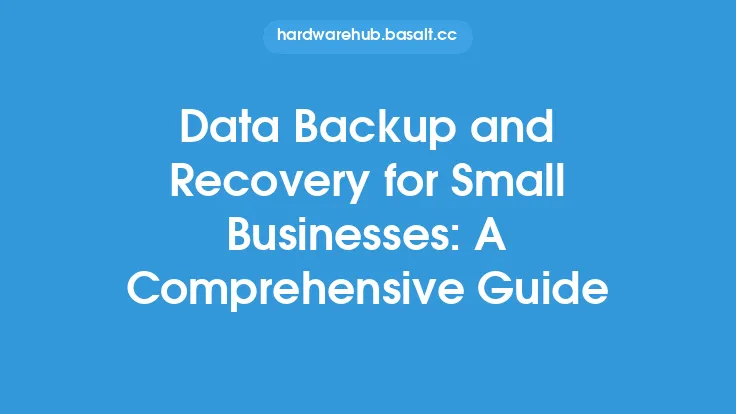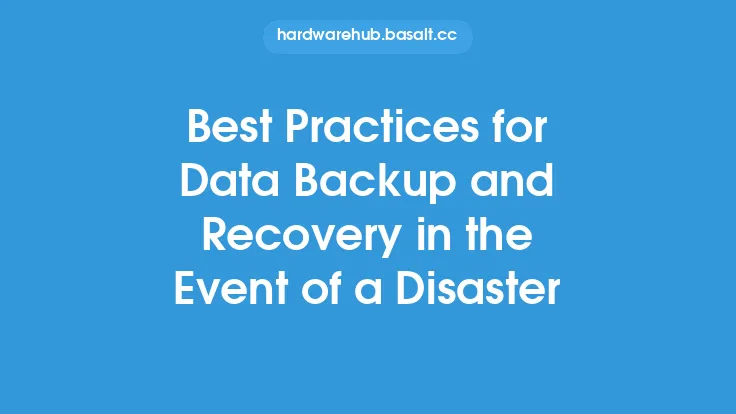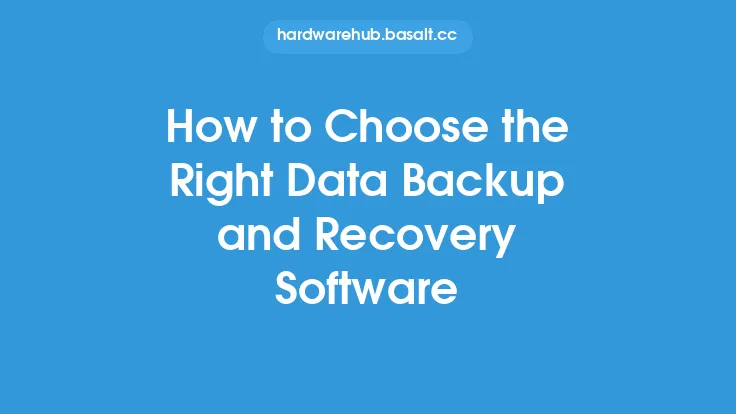Data backup and recovery are essential components of a comprehensive data management strategy. With the increasing reliance on digital data, it's crucial to have a solid understanding of the various methods and techniques used to protect and restore data in the event of a disaster or data loss. In this article, we'll delve into the world of data backup and recovery, exploring the different types of backups, storage media, and recovery methods.
Introduction to Data Backup Methods
Data backup methods can be broadly categorized into two main types: full backups and incremental backups. A full backup involves creating a complete copy of all data, whereas an incremental backup only copies the data that has changed since the last backup. There are also differential backups, which copy all data that has changed since the last full backup. Each type of backup has its own advantages and disadvantages, and the choice of method depends on the specific needs and requirements of the organization.
Storage Media for Data Backup
When it comes to storing backed-up data, there are several options available, each with its own strengths and weaknesses. External hard drives, solid-state drives (SSDs), and tape drives are popular choices for local backups, while cloud storage services, such as Amazon S3, Google Cloud Storage, and Microsoft Azure, offer a scalable and flexible solution for offsite backups. The choice of storage media depends on factors such as data volume, transfer speed, and cost. For example, tape drives are often used for large-scale backups due to their high capacity and low cost, while SSDs are preferred for their fast transfer speeds and low latency.
Data Compression and Encryption
Data compression and encryption are two important techniques used to optimize and secure backed-up data. Compression algorithms, such as gzip and zip, reduce the size of the data, making it faster to transfer and store. Encryption algorithms, such as AES and RSA, protect the data from unauthorized access, ensuring that even if the backup is compromised, the data remains secure. There are also various encryption protocols, such as SSL/TLS and SSH, that can be used to secure data in transit.
Data Recovery Methods
Data recovery involves restoring data from a backup in the event of a disaster or data loss. There are several data recovery methods, including file-level recovery, volume-level recovery, and bare-metal recovery. File-level recovery involves restoring individual files or folders, while volume-level recovery involves restoring an entire disk or partition. Bare-metal recovery, on the other hand, involves restoring a complete system, including the operating system, applications, and data, to a bare metal machine or a virtual machine.
Disk Imaging and Cloning
Disk imaging and cloning are two related techniques used to create an exact copy of a disk or partition. Disk imaging involves creating a bit-for-bit copy of a disk, including all data, operating system, and applications, while disk cloning involves creating a copy of a disk that can be used as a bootable replacement. Disk imaging and cloning are useful for creating backups of entire systems, as well as for deploying identical systems in a production environment.
Virtualization and Data Backup
Virtualization has revolutionized the way data is backed up and recovered. Virtual machines (VMs) can be easily backed up and restored, and virtualization platforms, such as VMware and Hyper-V, offer a range of backup and recovery tools. Virtualization also enables the creation of snapshots, which are point-in-time copies of a VM, allowing for quick recovery in the event of a disaster.
Cloud-Based Data Backup and Recovery
Cloud-based data backup and recovery have become increasingly popular in recent years, offering a scalable, flexible, and cost-effective solution for data protection. Cloud storage services, such as Amazon S3 and Google Cloud Storage, provide a range of backup and recovery tools, including file-level recovery, volume-level recovery, and bare-metal recovery. Cloud-based backup and recovery also enable disaster recovery as a service (DRaaS), which allows organizations to recover their data and systems in the cloud in the event of a disaster.
Best Practices for Data Backup and Recovery
While the specific data backup and recovery methods and techniques used may vary, there are several best practices that should be followed to ensure effective data protection. These include: (1) following the 3-2-1 rule, which involves creating three copies of data, storing two copies on different storage media, and storing one copy offsite; (2) testing backups regularly to ensure data integrity and recoverability; (3) using encryption and access controls to secure backed-up data; and (4) developing a comprehensive data backup and recovery plan that includes procedures for data backup, recovery, and disaster recovery.
Conclusion
In conclusion, data backup and recovery are critical components of a comprehensive data management strategy. By understanding the different types of backups, storage media, and recovery methods, organizations can develop effective data protection plans that ensure business continuity and minimize data loss. Whether using local backups, cloud storage, or a combination of both, it's essential to follow best practices, such as the 3-2-1 rule, and to regularly test backups to ensure data integrity and recoverability. By doing so, organizations can protect their valuable data assets and ensure that they can recover quickly and effectively in the event of a disaster or data loss.





